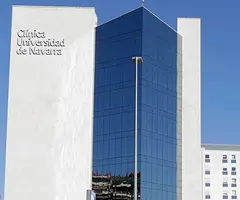Spinal neuronavigation
"Every patient is different, and neuronavigation makes it possible to tailor the surgery to each person's unique anatomy."
DR. VÍCTOR RODRIGO DIRECTOR. NEUROSURGERY DEPARTMENT

What is neuronavigation?
Spinal neuronavigation or spinal neuronavigation is a technology that guides the specialist in real time during spinal surgery, showing him or her the exact location of the patient's anatomical structures.
This system uses images obtained by computed tomography (CT or intraoperative scanning) to construct a three-dimensional model of the patient's spine. During the operation, these images are synchronized with special instruments that allow the surgeon to orient himself millimetrically in the patient's spine.
In our Neurosurgery Department, we have this state-of-the-art technology to offer you precise, effective procedures with less surgical risk.

Advantages of neuronavigation in spinal surgery
We have been the best private hospital in Spain tenth years in a row (2024 Health Reputation Monitor Ranking)
Increased safety,
lower risk
The possibility of avoiding critical structures translates into a significant reduction in the risk of complications when placing implants and performing decompressions.
Surgeries
less invasive
By improving orientation within the surgical field, in many cases smaller incisions can be made, with less postoperative pain and faster recovery.
Accuracy
millimeter
It allows the exact location of the problem -such as a tumor- to be pinpointed, causing less damage to adjacent tissues and nerve structures.
Surgical results
more predictable
The accuracy of the system contributes to more efficient surgery, with better clinical outcomes and less need for additional surgeries or revisions.
In what types of spine surgery is neuronavigation used?
Spinal neuronavigation can be used in multiple procedures in both adult and pediatric patients.
The most frequent are the placement of pedicle implants (screws) or intersomatic implants via the posterior route, although it is also used in other procedures such as the precise localization of intrathecal tumor lesions, facilitating their surgical resection. Likewise, it is especially useful in complex revision or reintervention surgeries, in which the usual anatomy is altered by previous procedures, fibrosis or extensive scarring.
In addition, neuronavigation is widely applied in surgical corrections of complex spinal deformities, such as scoliosis, kyphosis or post-traumatic deformities, as it allows for more precise surgical planning and execution.
Most frequent indications for spinal neuronavigation:
- Degenerative pathology of the spine (arthrosis, compressions, etc.).
- Scoliosis and complex deformities (kyphosis, pathological lordosis).
- Revision surgery (reinterventions after previous surgery).
- Vertebral and spinal tumors (resection or biopsy).
- Spondylolisthesis (fusion and spinal instrumentation).
- Complex traumatic fractures (placement of implants for stabilization).
Do you have any of these spinal problems?
Spinal neuronavigation could be beneficial for you
How is neuronavigation integrated into surgery?
The process begins in the operating room itself, with the patient's CT scan of the area to be treated. This information is loaded into the neuronavigation system, which generates an interactive three-dimensional map of the spine.
During surgery, the surgical instruments are equipped with special optical sensors. The system continuously detects the exact location of these instruments and projects it onto the previously obtained three-dimensional images of the patient.
This allows the neurosurgeon to move precisely and safely inside the body, having at all times accurate visual information on anatomical structures, implants and critical areas, as if he had an "inside view" in real time.
Postoperative recovery
Neuronavigation-assisted surgery is typically associated with:
- Shorter hospital stays, with an average reduction of 1–3 days compared to conventional techniques.
- Less need for postoperative pain medication.
- Earlier start of physical rehabilitation, enhancing functional outcomes.
- Faster return to daily and work activities.
- Lower reoperation rates due to complications related to implant placement.
Scars are generally smaller and more aesthetic, which is especially appreciated by patients. In addition, the less invasive approach reduces the risk of postoperative fibrosis and associated chronic pain.
Where do we do it?
IN NAVARRE
The Department of Neurosurgery
at the Clínica Universidad de Navarra
The Neurosurgery Department has specialists with a great deal of experience in care and research and the most advanced technology.
We are the first Spanish center that incorporates high field intraoperative magnetic resonance (3T). This allows the maximum precision and control in cranial surgery.
We are the Spanish medical center with the most experience in Parkinson's surgery by means of deep brain stimulation. We have the latest technology with localized ultrasound (HIFU) and extensive experience in treating essential tremor and Parkinson's disease without an incision.
Treatments we perform
- Alterations in the circulation of the cerebrospinal fluid
- Infusion Pumps
- Epilepsy Surgery
- Deep brain stimulation
- HIFU, high intensity ultrasound
- Trigeminal Neuralgia
- Pediatric Neurosurgery
- Neuronavigation of the spine
- Spine Pathology
- Brain Tumors
- Pituitary Tumors

Why in Navarre?
- The first Spanish center with a high field intraoperative magnetic resonance (3T).
- Precision and minimally invasive surgery.
- Experts in the use of HIFU for the treatment of tremor.




